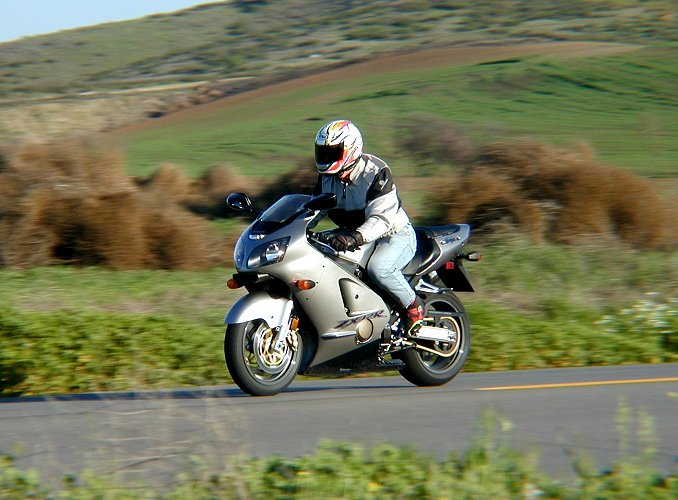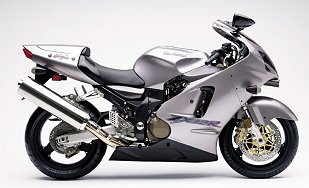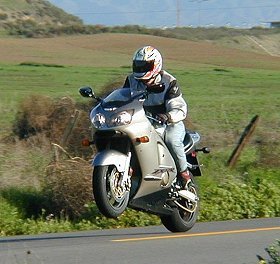
As I pulled away from Kawasaki’s Southern California headquarters on the 2001 ZX-12R a few weeks ago, I marveled at the forward thrust, both smooth and formidable, available with a careful twist of my right wrist. “Effortless power” is the thought that came to mind. I was also pleased to discover that it is far easier to keep the front wheel on the ground while using this thrust than it had been on Suzuki’s GSX-R1000 sportbike I tested a few months ago.
I had been looking forward to riding the ZX-12R since its announcement a year and one-half ago. Test units were certainly scarce in the U.S., however, and not a single one found its way into my hands. I was left to observe the press reports of others, and wonder why they were so inconsistent.
Winning comparison tests (or “shoot outs”) in European publications, and receiving relative praise from Cycle World here in the United States, the big Ninja was virtually crucified by Motorcyclist magazine. Like everyone else, I was puzzled by this and anxious to do my own “research”, if you will.
The ZX-12R certainly has the proper lineage. Kawasaki’s ZX-11 was the horsepower and speed king in the street legal motorcycle world for quite some time. Still a legend, the ZX-11 now constitutes a relatively comfortable and swift sport tourer, but its time had passed.
Eclipsed in the horsepower/speed wars by Honda’s CBR1100XX and then Suzuki’s incredibly powerful Hayabusa, Kawasaki developed the 12R to fight back. When members of the press got their hands on the 12R, an obsession with top speed resulted. Did the Kawasaki have a higher top speed than the Hayabusa? Who cares, I thought (and still do). I wanted to know if the 12R made a competent and entertaining real-world motorcycle.
I was convinced that less than one in 100 customers would ever use the top speed of a motorcycle like the 12R, much less care how far beyond 180 mph the bike would take them. I know there is a theory that top speed statistics sell motorcycles (and it may be true, to some extent), but I just knew MD’s readers were smarter than that. Performance in the real world is all about acceleration, not top speed. Today’s 600s have a top speed beyond a street rider’s needs. The Hayabusa and the 12R each have a top speed far beyond a street rider’s needs. Too much focus was put on this subject by too many publications.
The acceleration part of the performance equation is handled quite well by the 12R. Capable of high nine second quarter miles off the showroom floor, the 12R will simply blow your mind. Dedicated Hayabusa fans might argue the point, but the 12R was proven as quick or quicker than a Hayabusa in more than one comparison (take a look at Britain’s Fast Bikes magazine, June 2000 issue, for example). Perhaps, a little less torquey than the Hayabusa below 7,000 rpm, the ZX-12R nevertheless pulls extremely hard from 4,000 rpm and literally explodes above 7,000.

Moreover, the counter-balanced 1198cc engine never seems to break a sweat. The machine somehow communicates a degree of calmness and security to the rider, even while mimicking a bullet fired from a 357 magnum.
This feeling of calmness and security is both good and bad. It is good for an experienced rider, because the lack of drama allows him to focus on the task at hand, i.e., piloting a supremely powerful and capable machine through a world populated by dangerous “cages”. It is bad only where it could lead a less experienced rider to misapprehend his (or her) velocity. This is clearly a bike for experienced riders, only.
So, the speed freaks among us will not be disappointed by the ZX-12R. Moreover, Kawasaki has catered to the more practical side of street riders with sane ergonomics, relatively generous wind protection, and a well balanced chassis with powerful brakes.
Like Kawasaki’s smaller sportbikes, the 12R has a riding position that resides somewhere between extreme race and sport tourer. Fortunately, the bars are well placed, because they are cast as a single piece with the upper triple clamp and would be expensive to replace. The footpegs are also a good compromise between sporty and sport tourer, and the whole bike allows larger riders to stretch out.
While the riding position and wind protection make the 12R a fairly comfortable long distance mount (for a sportbike) in the tradition of the ZX-11, the 12R is surprisingly nimble. Surprisingly, because it is a 1200, after all. Riding the 12R back-to-back with a new 600, the 12R felt agile. Certainly not in the same class as a 600, but quick handling nonetheless. Credit here goes to relatively aggressive chassis geometry.
The 12R doesn’t sacrifice stability for its nimbleness. This is perhaps the best aspect of the bike’s handling traits. Like other Kawasaki sportbikes, the 12R feels solid and “planted” mid corner, and at high speeds in a straight line. Kawasaki has struck a good balance between quick turn-in and stability.
The transmission is slightly notchy, but sure shifting. You always get the next gear you want (no false neutrals). With tall gearing and mega-power, the 12R is frequently a single gear affair. Third gear, for instance, will serve you quite well from 30 mph to 100 mph (or more), if you wish.

Not surprisingly, Kawasaki equipped the 12R with powerful brakes. Feedback from the brakes was good, as well, although not quite up to the high standards set by Kawasaki’s own ZX-6R. As received, the fork was a bit soft and aggressive braking caused significant fork dive. This could probably have been dialed out, however.
Both the fork and the shock are adjustable for spring preload, compression and damping. This is on par with the latest and greatest sportbikes, and is much appreciated. Every bike in this class should have fully adjustable suspension (but they don’t).
Off/on throttle transitions revealed some abruptness from the fuel injection system, but this was only noticeable mid-corner, and is something that the rider could compensate for with practice. Overall, the fuel injection works quite well, and suffers only by comparison with the latest and best fuel injected bikes (notably, Honda’s CBR600F4i, which sets the new standard in my opinion).
The super stiff monocoque chassis does transmit some vibration to the rider, particularly between 4,000 and 5,000 rpm. In general, however, this vibration constitutes welcome feedback more than annoyance. The bike as a whole communicates well with the rider (from the tire patches and the engine bay). Riding the 12R is not a feeling of isolation — it is a feeling of involvement.
Kawasaki’s ZX-12R is not for everyone. It is not for the meek. It is not for the timid. It is not for the inexperienced. It is not for those desiring a motorcycling experience that cossets and isolates them.
It is a machine for the experienced rider who wants the raw acceleration only available in the hypersports category in a package that combines reasonable ergonomics and class-leading handling. The fact that it is the direct descendent of the bike that arguably created the hypersports category in the first place, the ZX-11, is an added bonus.
The U.S. MSRP of the 2001 Kawasaki ZX-12R is $11,999.00. Follow this link to Kawasaki’s website for specifications and other details.





